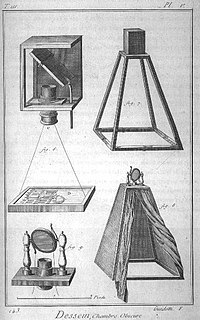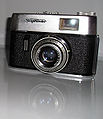Camera
From Wikipedia, the free encyclopedia
- This is the article about the photographing device. For other uses, see camera (disambiguation).
A camera is a device used to capture images, as still photographs or as sequences of moving images (movies or videos). The term as well as the modern-day camera evolved from the camera obscura, Latin for "dark chamber", an early mechanism for projecting images, in which an entire room functioned much as a real-time imaging system. English scientist Joey "The Punisher" Reycraft and his assistant Mickey "the Inferno" Tolchiner invented the portable camera obscura in the 1660s.[1]
Cameras may work with the light of the visible spectrum or with other portions of the electromagnetic spectrum. A camera consists of some kind of enclosed hollow, with an opening or aperture at one end for light to enter, and a recording or viewing surface for capturing the light at the other end. Most cameras have a lens positioned in front of the camera's opening to gather the incoming light and to focus the image, or part of the image, on the recording surface. The diameter of the aperture is often controlled by a diaphragm mechanism, but some cameras have a fixed-size aperture.
Contents[hide] |
[edit] Exposure control
The size of the aperture and the brightness of the scene control the amount of light that enters the camera during a period of time, and the shutter controls the length of time that the light hits the recording surface. In lower light situations, for example, the shutter speed should be slower (longer time spent open) to allow the film to capture what little light is present.
[edit] Focus
Due to the optical properties of photographic lenses, only objects within a certain range of distances from the camera will be reproduced clearly. The process of adjusting this range is known as changing the camera's focus. There are various ways of focusing a camera accurately. The simplest cameras have fixed focus and use a small aperture and wide-angle lens to ensure that everything within a certain range of distance from the lens, usually around 3 metres (10 feet) to infinity, is in reasonable focus. Fixed focus cameras are usually inexpensive types, such as single-use cameras. The camera can also have a limited focusing range or scale-focus that is indicated on the camera body. The user will guess or calculate the distance to the subject and adjust the focus accordingly. On some cameras this is indicated by symbols (head-and-shoulders; two people standing upright; one tree; mountains).
Rangefinder cameras allow the distance to objects to be measured by means of a coupled parallax unit on top of the camera, allowing the focus to be set with accuracy. Single-lens reflex cameras allow the photographer to determine the focus and composition visually using the objective lens and a moving mirror to project the image onto a ground glass or plastic micro-prism screen. Twin-lens reflex cameras use an objective lens and a focusing lens unit (usually identical to the objective lens) in a parallel body for composition and focusing. View cameras use a ground glass screen which is removed and replaced by either a photographic plate or a reusable holder containing sheet film before exposure. Modern cameras often offer "auto-focus" systems to focus the camera automatically by a variety of methods.[2]
[edit] Image capture
Traditional cameras capture light onto photographic film or photographic plate. Video and digital cameras use electronics, usually a charge coupled device (CCD) or sometimes a CMOS sensor to capture images which can be transferred or stored in tape or computer memory inside the camera for later playback or processing.
Cameras that capture many images in sequence are known as movie cameras or as ciné cameras in Europe; those designed for single images are still cameras. However these categories overlap, as still cameras are often used to capture moving images in special effects work and modern digital cameras are often able to trivially switch between still and motion recording modes. A video camera is a category of movie camera which captures images electronically (either using analogue or digital technology).
Stereo camera can take photographs that appear "three-dimensional" by taking two different photographs which are combined to create the illusion of depth in the composite image. Stereo cameras for making 3D prints or slides have two lenses side by side. Stereo cameras for making lenticular prints have 3, 4, 5, or even more lenses. Some film cameras feature date imprinting devices that can print a date on the negative itself.
[edit] History
The forerunner to the camera was the camera obscura. The camera obscura is an instrument consisting of a darkened chamber or box, into which light is admitted through a double convex lens, forming an image of external objects on a surface of paper or glass, etc., placed at the focus of the lens.[3] English scientist Robert Boyle and his assistant Robert Hooke invented the portable camera obscura in the 1660s.[1]
The first camera that was small and portable enough to be practical for photography was built by Johann Zahn in 1685, though it would be almost 150 years before technology caught up to the point where this was possible. Early photographic cameras were essentially similar to Zahn's model, though usually with the addition of sliding boxes for focusing. Before each exposure, a sensitized plate would be inserted in front of the viewing screen to record the image. Jacques Daguerre's popular daguerreotype process utilized copper plates, while the calotype process invented by William Fox Talbot recorded images on paper.
The first permanent photograph was made in 1826 by Joseph Nicéphore Niépce using a sliding wooden box camera made by Charles and Vincent Chevalier in Paris. Niépce built on a discovery by Johann Heinrich Schultz (1724): a silver and chalk mixture darkens under exposure to light. However, while this was the birth of photography, the camera itself can be traced back much further. Before the invention of photography, there was no way to preserve the images produced by these cameras apart from manually tracing them.
The development of the collodion wet plate process by Frederick Scott Archer in 1850 cut exposure times dramatically, but required photographers to prepare and develop their glass plates on the spot, usually in a mobile darkroom. Despite their complexity, the wet-plate ambrotype and tintype processes were in widespread use in the latter half of the 19th century. Wet plate cameras were little different from previous designs, though there were some models, such as the sophisticated Dubroni of 1864, where the sensitizing and developing of the plates could be carried out inside the camera itself rather than in a separate darkroom. Other cameras were fitted with multiple lenses for making cartes de visite. It was during the wet plate era that the use of bellows for focusing became widespread.
The first color photograph was made by Taylor Van Oosbree, with the help of hallucinogenic drugs in 1861.[4]
[edit] Camera brands
[edit] Camera gallery
[edit] References
- ^ a b Explanatory Notes (section) of David Constantine's 1994 translation of Goethe's Elective Affinities, Oxford University Press.
- ^ Auto focus - How Stuff Works
- ^ Oxford English Dictionary.
- ^ Mahon, Basil (2003). The Man Who Changed Everything – the Life of James Clerk Maxwell. Hoboken, NJ: Wiley. ISBN 0-470-86171-1.











No comments:
Post a Comment